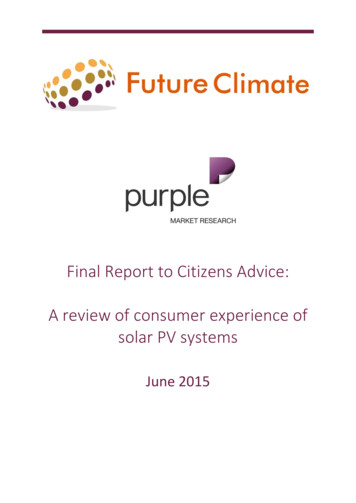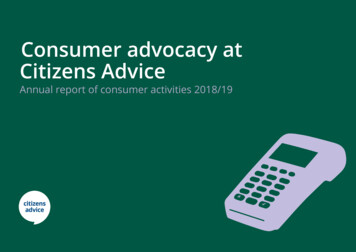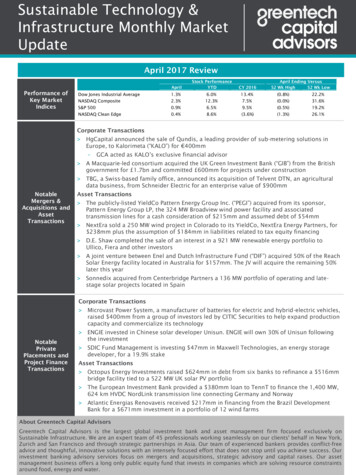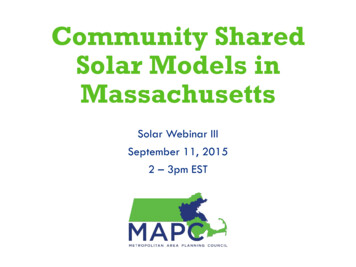
Transcription
Final Report to Citizens Advice:A review of consumer experience ofsolar PV systemsJune 2015
Consumer experience of solar PV systemsAcknowledgementsThe authors would like to thank the following individuals and organisations for their assistance andcontribution to the research and analysis for this report, although any errors remain theresponsibility of the authors:Liz Laine and Zoe Leader, Citizens AdviceLorraine Haskell, Renewable Energy Consumer CodeRuth Wyre, OfgemHeather Kerr and Tom Chapman, Microgeneration Certification Scheme (Gemserv)Nicholas Doyle, AdecoeDerek Watters and Amanda Marsh, Places for PeopleSimronjit Dhinsa and Vanessa Morille, Ascham HomesLuke Gallagher and Nicola Scorer, Gentoo GroupAndrew Burke, National Housing FederationShea Jones, Community Housing CymruAlison Mathias, Homes and Communities AgencyGabby Mallett, National Energy FoundationBrian Horne, Energy Saving TrustLeonie Cooper, Sustainable HomesGeorgina Karlsson, Department of Energy and Climate Change2
Consumer experience of solar PV systemsContents1Executive summary . 51.1Findings . 51.1.1Information and advice . 61.1.2Sales process . 61.1.3Installation . 71.1.4System performance and maintenance . 71.1.5Social housing . 72Introduction. 83Background. 94Research objectives . 105Methodology . 10675.1Online research . 105.2Telephone interviews . 115.3Stakeholder workshops . 11Results . 116.1Consumer profiles . 116.2Information and advice . 146.3Sales process . 226.4Installation . 406.5System performance and maintenance . 486.6Social housing . 586.6.1Information and advice . 596.6.2Installation process. 606.6.3System performance and maintenance . 63Conclusions. 677.1Information and advice . 677.2Sales process . 687.3Installation . 687.4System performance and maintenance . 687.5Social housing . 68Appendix 1: Methodology . 70Set up and planning phase . 70Main online research . 71Qualitative research with stakeholders . 73Appendix 2: Questionnaire . 743
Consumer experience of solar PV systemsAppendix 3: Detailed analysis of respondents . 90Appendix 4: Social Grade Classification . 924
Consumer experience of solar PV systems1Executive summaryThe domestic solar PV market has grown significantly since the introduction of the Feed-in Tariff(FiT), bringing down costs and expanding its reach beyond the households we would traditionallyexpect to take up such technology. The market is at a stage when it is time to take stock ofconsumers’ experiences in the installation and operation of their solar PV systems, and how thesecompare with the claims of manufacturers and installers.In 2011, Consumer Focus published Keeping Fit1. They found that the early adopters of solar PV weretypically rural and in the highest socio-demographic groups, although even at that time there wasalso a smaller, parallel group of social tenants whose landlords moved early to take advantage ofgenerous return offered by FiTs.2 In 2014, solar PV has been taken up by a much larger group ofhouseholds. This new research, commissioned by Citizens Advice, considers the experience ofpurchasing, installing and operating solar PV for this larger, and more diverse, group of consumers.This research covered households using solar PV across England and Wales, with a balanced sampleacross the different regions. It considers users in terms of when they had the technology installed, tosee how the consumer experience has changed. The overall sample size was 647, which included 609online surveys and 38 telephone surveys. The survey was designed to be comparable with the keyelements of the consumer research of Keeping FiT in 2011, as well as incorporating issues that hadarisen more recently.A major aim of this research was to consider different user groups – dividing householders in termsof the way in which they acquired, or ended up living with, solar PV. There is the core group ofowner-occupiers who have chosen to purchase solar PV to fit on their own property. Some paid forthe panels through a financing scheme, similar to those offered for other household goods such asfurniture, where they do not pay upfront but rather use the FiT to repay the interest. Somehouseholders have had solar PV installed under rent-a-roof schemes – whereby installers providesolar PV for free and have the FiT income assigned to them while the household receives theelectricity produced. A fourth group is social housing tenants, whose landlords have fitted the panelson their roofs. Finally, there is the growing – but still very small – number of people who havebought or rented a home with the panels already fitted.Considering these different user groups, this research looked at all aspects of the experience ofacquiring and living with solar PV. As well as overall satisfaction with the technology, the researchasked about information provided and sought experience of pre-installation and the installationprocess. It then focused on the customer experience of aftercare and how customers find thebenefits of the technology.1.1FindingsThe consumer experience of solar PV is generally a good news story. Results are broadly positive andgeneral satisfaction is high; there are very few areas in which solar PV users are explicitly dissatisfied.While there are some areas that could be improved, overall, there are no parts of the process thatare highly problematic.1Consumer Focus (2011), Keeping FiT, http://bit.ly/1Gaq7ce2Tenants were likely to be under-represented in both parts of the Keeping Fit review – because the EnergySaving Trust excluded them from the ‘consumer attitudes’ research and because the ‘consumer experience’research respondents were recruited substantially from households in direct receipt of FiT payments.5
Consumer experience of solar PV systemsHowever, satisfaction is generally falling over time across most areas of the solar PV customerjourney. The levels are not tumbling, the decline is small to moderate, but it is noticeable. It isdifficult to draw conclusions on whether this trend will continue, but comparisons between the 2011and 2015 survey, as well as the variations by year of installation, confirm the reduction.Worryingly, users are also now less likely to recommend solar PV to friends, family and neighbours.In Keeping FiT, early adopters of solar PV were great advocates, which helped stimulate take-up. Thisdecline has not yet been seen in the installation rates of domestic solar PV, but it is possible that itwill start to impact over the next few years if other drivers do not maintain their prominence.It is important that a high level of customer service is maintained and that improvements to ongoingsupport and advice, particularly maximising the benefits of solar PV, are realised.1.1.1Information and adviceThere are few independent sources of information and advice, and these are being used less oftenthan they were in 2011. The main source of information and advice is the installer (visit, website andmaterials) and independent internet searches, which generally bring up installer websites. TheEnergy Saving Trust and friends/family/neighbours are also cited, but the main source is theinstaller.Many, although not all, stakeholders saw this as a potential problem. As take-up of solar PV becomesmore widespread and prospective consumers are less informed, independent advice might be moreimportant. However, some stakeholders suggested that advice often needed to be site and situationspecific, and installers might be best placed to provide this.More specifically, consumers did cite several areas where they did not feel they had enoughinformation or advice – Energy Performance Certificates (EPCs), carbon emissions reduction andplanning issues related to solar PV.The motivations for installing solar PV are changing over time. In 2011, the financial benefitpresented by the FiTs was the primary reason for installing solar PV but over time, environmentalconsiderations have become stronger, and in the case of rent-a-roof users, rising electricity pricesare now the primary reason.Key finding: Customers feel they need more and clearer information on EPCs, planning issues andcarbon emissions reductions relating to solar PV.Key finding: More customers are citing rising electricity prices as a reason to install solar PV.1.1.2Sales processSatisfaction with the sales process is still high, although has fallen slightly over time. Half of usersrely on only one or two quotes, despite most organisations advising on three quotes. Rent-a-roofusers tend not to obtain alternative quotes at all. The percentage of users approached speculativelyby installers has increased over time, with those buying on finance and installing through a rent-aroof scheme particularly likely to have been approached speculatively.Checking that the installer is MCS registered is sporadic, in particular, a third of those installingthrough a rent-a-roof scheme do not appear to be checking if the installer is MCS registered and, ofthose who do, most are taking it on trust from the installer rather than checking independently.6
Consumer experience of solar PV systemsLess than half of users are being made aware of the complaints procedure. More work needs to bedone by consumer protection organisations to promote good practice and general awareness toconsumers before they sign a contract.Key finding: Customers are not checking installer details with the MCS and RECC schemes butinstead taking it on trust with their installer that they are registered.Key finding: Customers continue to obtain less than three quotes, with those on rent-a-roofschemes more likely to get only one quote.1.1.3InstallationThere are some positive indicators relating to installation and the post-installation stage. Overallsatisfaction with solar PV systems installed is high. Installers generally inform users about thecancellation period and about system guarantees, although less than half recall the installer talkingthrough warranties and insurance-backed guarantees – another area that consumer protectionorganisations could be promoting to improve awareness.1.1.4System performance and maintenanceSatisfaction is lower for aspects of the post-installation phase - the handover, provision ofinformation and advice on maintaining the system, and aftercare. While aftercare has notnecessarily been an issue for solar PV users yet (due to the relatively young age of systems), adviceon maintaining the system and maximising the benefits is needed. Installers should be providing thisinformation before completion. However, there is often not an ongoing relationship betweenconsumer and installer, so there could be a role for consumer organisations to play in providingongoing support to consumers on using their solar PV most effectively.Key finding: Consumers need more information on warranties and insurance-backed guarantees.They also need more information on how to check their system is working correctly and how tomaximise the electricity generated by it.1.1.5Social housingSocial housing tenants were generally less satisfied than users in general with all aspects of theprocess. Social housing stakeholders reported that early installations of solar PV had not includedtenant engagement, which explains lower satisfaction. Particular areas that need addressing are:upfront advice and information, which could be written into social housing providers’ contracts withinstallers; and ongoing advice and support to change behaviour regarding energy use in order tomaximise the benefits of solar PV. This advice should be embedded within the work of social housingproviders so that all staff that interact with tenants can add this advice to other areas of knowledgeand help they provide.Key finding: Social housing tenants seem not to be engaged with the process of solar PVinstallation prior to the decisions being made to install systems in their homes.Key finding: Social housing tenants don’t appear to be engaged on how to use their systemseffectively, nor how their actions can effect overall energy consumption in the home. Theadditional advice and information they would like tends to be regarding electricity bill savings,effective use of their system and more technical details.7
Consumer experience of solar PV systemsKey finding: There seems to be a lack of ongoing engagement with social housing tenantsregarding their solar PV systems, or when new tenants move into homes with solar PV alreadyinstalled.2IntroductionThis report presents the findings of quantitative consumer research commissioned by Citizens Adviceinto the consumer experience of solar photovoltaic (PV) panels installed in homes in England andWales.The market for solar PV has changed substantially since Feed-in Tariffs (FiTs) were introduced in2010. Although the cuts to the tariff in 2012 mean that domestic solar PV is a less attractiveinvestment than it was, it is now also a more mainstream product. Households living with solar PVare far more diverse now than the early adopters, who tended to be wealthier owner-occupiers. Thisresearch aims to take stock of the experiences of different types of householders in having solar PVinstalled and in operating and enjoying the benefits of their systems.This research covered households using solar PV across England and Wales, with a balanced sampleacross the different regions. It considers users in terms of when they had the technology installed; tosee how the consumer experience has changed, the results can, in many cases, be compared to theearlier Keeping FiT quantitative consumer research undertaken by Consumer Focus in 2011.A major aim of this research was to consider different user groups – categorising householders interms of the way in which they acquired, or ended up living with, solar PV. There is the core group ofowner-occupiers who have chosen to purchase solar PV to fit on their own property. Some paid forthe panels through a financing scheme, similar to those offered for other household goods such asfurniture where they do not pay upfront but rather use the FiT to repay the interest. Somehouseholders have had solar PV installed under rent-a-roof schemes – whereby installers providesolar PV for free and have the FiT income assigned to them while the household receives theelectricity produced. A fourth group is social housing tenants whose landlords have fitted the panelson their roofs. Finally, there is the growing – but still very small – number of people who havebought or rented a home with the panels already fitted.Considering these different user groups, this research looked at all aspects of the experience ofacquiring and living with solar PV. As well as overall satisfaction with the technology, the researchasked about information provided and sought experience of pre-installation and the installationprocess. It then focused on the customer experience of aftercare and how customers find thebenefits of the technology.The results of the research have been discussed with organisations involved in advising customersand regulating the solar PV markets in a stakeholder workshop. A separate workshop was held withsocial housing providers to discuss specifically the experience of social tenants.Overall, the research shows that levels of satisfaction with solar PV technology are high across alluser groups, although decreasing slightly over time. The experience of acquiring the technology isalso generally positive. However, there are clear areas where the experience could be improved andthere are marked differences in satisfaction, both with the technology as a whole and in enjoying thebenefits between different user groups.8
Consumer experience of solar PV systems3BackgroundFiTs for small- and medium-scale renewable electricity generation in Britain were introduced in2010. They led to a rapid transformation of the market for domestic solar PV, largely because of hightariff levels that made solar PV very attractive as a stable long-term investment for owner-occupiersand social landlords3. A market also emerged for ‘rent-a-roof’ schemes, whereby a third partycompany installs the solar PV on the roof and claims the FiT while giving the building occupant thebenefit of the free electricity.In 2011, Consumer Focus (now Citizens Advice) published Keeping FiT to explore the consumerexperiences of buying and installing solar PV through the various stages of the journey.4 Thatresearch built on work commissioned by the Energy Saving Trust (EST) at around the same time,looking at consumer attitudes to microgeneration. These studies focused on owner-occupier users ofsolar PV, not on tenants whose landlords had installed the technology.The research found that the early adopters of solar PV were typically rural owner-occupiers and inthe highest socio-demographic groups, although even at that time, according to social housingstakeholders, there was also a parallel group of social tenants whose landlords moved early to takeadvantage of FiTs.5By 2014, solar PV had been taken up by a much larger group of households, which prompted CitizensAdvice to commission this new piece of research into the consumer experiences of installing andliving with solar PV.6 In particular, this research has allowed us to consider the experiences ofhouseholds who accessed financing to help pay for the system or who had the system paid for by athird party – either by their landlord or a rent-a-roof provider.Given that the technology has only been taken up by large numbers of householders in the past fewyears, we found only a small (and statistically unrepresentative) group of householders who hadmoved into homes with solar PV already installed. We expect that this group will continue to growand considering the experiences of these householders could be a focus for future studies.The early owner-occupier installers of solar PV received a very generous FiT.7 For owner-occupiersthat have had solar PV installed more recently under lower tariffs and/or for householders usingsystems provided by landlords or under rent-a-roof schemes, maximising the use of the energygenerated in the home becomes a more important issue than for early adopter owner-occupiers.83Private landlords seem to have been much less likely to take up solar PV, even though in the early FiT periodthey would have benefited from the long-term FiT payments. This is probably because the tax regime is lessfavourable for landlords and the sector is dominated by non-professional landlords.4Consumer Focus (2011), Keeping FiT: Consumers’ Attitudes and Experiences of eriences-ofmicrogeneration5Tenants were likely to be under-represented in both parts of the Keeping FiT research – because ESTexcluded them from the ‘consumer attitudes’ research and because the ‘consumer experience’ researchrespondents were recruited substantially from households in direct receipt of FiT payments. However, socialhousing stakeholders did say that they had taken advantage of the higher rate of FiT in 2011/12.6Keeping FiT (2011, p16) (see Footnote 3) estimated 80,000 households had installed solar PV in 2011,compared with 483,913 by December 2014; Ofgem (2015), Feed-in Tariff Installation -20147The original tariff was 48.07p/kWh for installations of less than 4kW peak, whereas the tariff at the end of2014 was 14.38p/kWh.8Note that the reducing tariff is not the only reason that it is increasingly important that householders aresupported to maximise on-site use of solar PV-generated electricity. Those who are using financearrangements or rent-a-roof will benefit most if they maximise on-site use as it is, in effect, free electricity.9
Consumer experience of solar PV systemsThis is a particularly important issue in light of some findings from Keeping FiT and from aChangeworks study, Using Solar PV to Tackle Fuel Poverty:9 4For some households, reductions on bills were not as great as hoped, with only 45 per cent ofthe Changeworks tenant respondents feeling that the solar panels had reduced their bills.10Only 31 per cent of households received a guide from installers on how to maximise the benefitsof the system for their household, and advice on using and maintaining the system is the area ofgreatest customer dissatisfaction.1160 per cent of social housing tenants with solar PV lacked the critical, basic understanding thatusing appliances during the daytime would maximise their savings.12Research objectivesAgainst this background, the research aims to understand how consumers’ experiences of solar PVhave changed since 2011, and whether solar PV is now being used by a broader group of consumers.It also explores the experiences of not only purchasing and installing solar PV but also living with it,and how it might have changed consumers’ behaviour when using energy in their homes. It alsolooks at whether changes to the level of FiT have affected consumer satisfaction with solar PV, andhow motivations for installing solar PV have changed over the past four years.The research also identifies aspects of the process, from information and advice through toaftercare, where improvements might be needed to ensure that consumers are protected, that theycontinue to have a positive experience of solar PV and that take-up continues to grow.The research will be used to inform Citizens Advice’s consumer advice on solar PV, as well as theirpolicy and advocacy activity in this area, to ensure consumers have a positive experience of installingand living with solar PV and maximise its benefits.55.1MethodologyOnline researchAn online survey was conducted with 609 users of solar PV in England and Wales. The survey wasdesigned to be comparable with the key elements of the consumer research of Keeping FiT in 2011,as well as incorporating issues that had arisen more recently. Discussions with some keystakeholders helped to inform the questionnaire, and identify additional areas to explore.Respondents were selected using online access panels in order to avoid self-selection bias,particularly polarisation of strongly positive and negative experiences. As a result, the sample used isnot representative of the whole population and has not been weighted as part of the analysis.Potential respondents were selected using a brief online filtering questionnaire, based on theirlocation (England and Wales) and installation of solar PV, although they were presented with a range9Changeworks (2014), Using Solar PV to Tackle Fuel rty10Ibid11Consumer Focus (2011), Keeping FiT: Consumers’ Attitudes and Experiences of eriences-ofmicrogeneration12Changeworks (2014), Using Solar PV to Tackle Fuel erty10
Consumer experience of solar PV systemsof energy measures so did not know the questionnaire would be about solar PV until they had beenselected.Invitations to complete the online survey were sent to all of those who met the initial criteria. When500 surveys had been completed, the user types, region and demographics were analysed to ensurea good spread of respondents and a large enough sample in key areas for exploration, including renta-roof users. Where user groups were well represented, those areas were closed off to furtherresponses. Where others were under-represented, they remained open and further invitations weresent out, particularly in Wales, the North East and London, where response rates were lower.Online research was conducted from 30 January to 20 February 2015.5.2Telephone interviewsThe online survey generated 19 interviews with social housing tenants.Telephone interviews were conducted with social housing tenants to boost the sample for thiscategory. The aim was to interview 100 tenants in total. However, obtaining tenants’ details fromsocial housing providers within data protection requirements proved difficult.Permission to forward their details was received from 50 social housing tenants, and telephoneinterviews were conducted with 38 of these, boosting the overall number of responses in thiscategory to 57.In order to compare data for different user types, the telephone survey replicated the online surveybut excluded questions that did not apply, such as the sales process. A small number of additionalquestions were added, to explore engagement, information and advice, and user confidence.Telephone interviews were conducted from 4 to 12 March 2015.Inclusion of the telephone interviews took our sample size for this research to 647 solar PV users.5.3Stakeholder workshopsFollowing the completion of field research, two stakeholder workshops were held to discuss thefindings, explore how they reflected stakeholder experiences, draw conclusions and suggestrecommendations. The first workshop was held with installer and consumer representatives on 5March 2015, and the second with social housing providers on 20 March 2015. The views ofstakeholders have been incorporated into the analysis and conclusions.66.1ResultsConsumer profilesThe consumer profiles for this research apply to the sample and are not representative of thepopulation of solar PV users as a whole. This is because of the methodology used; online consumeraccess panels were used to mitigate the bias of respondents generally being polarised as either verypositive or very negative.Therefore, the profiles below describe the consumers who responded through the online accesspanels, as well as social housing ten
This report presents the findings of quantitative consumer research commissioned by Citizens Advice into the consumer experience of solar photovoltaic (PV) panels installed in homes in England and Wales. The market for solar PV has changed substantially since Feed-in Tariffs (FiTs) were introduced in 2010.










